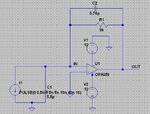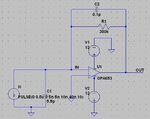Follow along with the video below to see how to install our site as a web app on your home screen.
Note: This feature may not be available in some browsers.
There is not a lot of difference between those two figures, but for a laser rangefinder it is the precision of the rising edge which is important not the pulse width. For example, if the pulse was 100ns long, it wouldn't help the precision of the edge if you had a low bandwidth based on the overall pulse width.
Keith.
hi,
actually for simulating a photodiode, can i really use a pulse current source with the amplitude of the supposed photocurrent?






Look sharp at the OPA653 internal circuit. It doesn't work as a TIA, just a 100 ohm or so C/V converter. The output signal is respectively low.why is it that my BW earlier of slighty over 50MHz couldn't even detect the output waveform but this new circuit with about so much larger of 180MHz is able to?
Look sharp at the OPA653 internal circuit. It doesn't work as a TIA, just a 100 ohm or so C/V converter. The output signal is respectively low.